
The Basilica dell'Osservanza is a church on the outskirts of Siena, region of Tuscany, Italy.

The Basilica dell'Osservanza is a church on the outskirts of Siena, region of Tuscany, Italy.
A hermitage is known at the site since 1192, and in 104 was donated to San Bernardino of Siena, who began construction of a church around 1420, consecrated in 1451 by the Archbishop Niccolo Piccolomini, and completed around 1490, probably designed by Francesco di Giorgio (Cecco di Giorgio). Further expansion of the church was commissioned between 1495 and 1496 by Pandolfo Petrucci.
An inventory in 1840 recalls organ doors painted by Lorenzo Feliciati. The first chapel on the right had wall frescoes by Apollonio Nasini, the second chapel, had frescoes by his uncle Tommaso. The main altar had terra-cotta statues sculpted by Gioco di Gambassi. Other sculptures by Giuseppe Mazzuoli the Younger. A crucifix painted by Riccio. Four canvases were painted by Franellini, and the pilasters had terra cotta reliefs by Della Robbia depicting an Annunciation. In the choir were paintings by Pietro di Giovanni and Ansano di Pietro.
The first chapel on the left had a painting of Santa Petronilla (1413) by Taddeo Bartoli; a Santa Filomena by Boschi, and frescoes by Franchini. Another chapel had a San Bernardino by Montorselli, with frescoes by Antonio Nasini. The third chapel had an altarpiece by Luca Della Robbia.
In the sacristy were works by Cozzarelli and the tomb of Pandolfo Petrucci. The walls had paintings by Margaritone d'Arezzo, Stefano di Giovanni, Alessandro Casolani, and Ramacciotti. An elaborate urn (1472) by Francesco d'Antonio contained the vestments of San Bernardino.
The adjacent convent's design was attributed to Peruzzi, and was said to have housed both Pius II (1459) and Pius VI (1798) during visits to Siena. The former cells of San Bernardino and San Giovanni di Capistrano were found here. The refectory had a Last Supper painted by Prete Franci. [1]
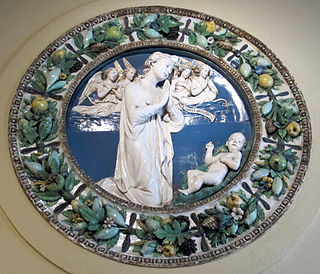
Luca della Robbia was an Italian sculptor from Florence. Della Robbia is noted for his colorful, tin-glazed terracotta statuary, a technique which he invented and passed on to his nephew Andrea della Robbia and great-nephews Giovanni della Robbia and Girolamo della Robbia. Though a leading sculptor in stone, he worked primarily in terracotta after developing his technique in the early 1440s. His large workshop produced both cheaper works cast from molds in multiple versions, and more expensive one-off individually modeled pieces.
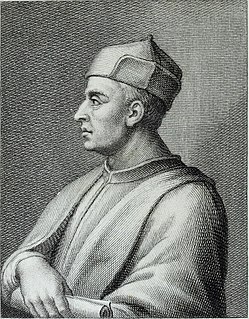
Luca Signorelli was an Italian Renaissance painter who was noted in particular for his ability as a draftsman and his use of foreshortening. His massive frescoes of the Last Judgment (1499–1503) in Orvieto Cathedral are considered his masterpiece.

Lorenzo di Pietro, known as Vecchietta, was an Italian Sienese School painter, sculptor, goldsmith and architect of the Renaissance. He is among the artists profiled in Vasari's Le Vite delle più eccellenti pittori, scultori, ed architettori.
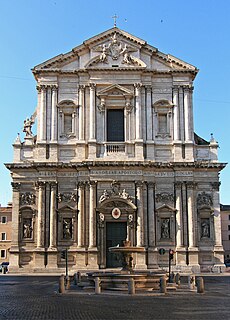
Sant'Andrea della Valle is a minor basilica in the rione of Sant'Eustachio of the city of Rome, Italy. The basilica is the general seat for the religious order of the Theatines. It is located at Piazza Vidoni, 6 at the intersection of Corso Vittorio Emanuele and Corso Rinascimento.

Girolamo Genga was an Italian painter and architect of the late Renaissance, Mannerist style.

The Basilica of Saint Mary of the Angels is a Papal minor basilica situated in the plain at the foot of the hill of Assisi, Italy, in the frazione of Santa Maria degli Angeli.

Giuseppe Nicola Nasini was an Italian painter of the Baroque period, active in Rome and Tuscany.
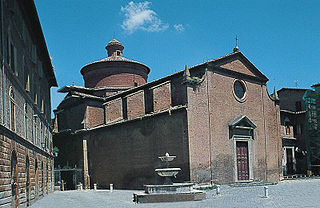
Santo Spirito is a Renaissance style, Roman Catholic church located in piazza Santo Spirito, where Via dei Pispini meets Vicolo del Sasso, in Siena, Italy.

The Basilica of San Domenico, also known as Basilica Cateriniana, is a basilica church in Siena, Tuscany, Italy, one of the most important in the city.

Giovanni Monevi or Monevo was an Italian painter of the Baroque period. The name Giovanni Moneri is used by a number of authors, but may reflect a misspelling.

The Basilica of Our Lady of Humility or Madonna dell'Umiltà is a Renaissance-style, Roman Catholic Marian basilica in Pistoia, region of Tuscany, Italy.

Volterra Cathedral is a Roman Catholic cathedral in Volterra, Italy, dedicated to the Assumption of the Virgin Mary. It is the seat of the bishop of Volterra.
Francesco Nasini was an Italian painter of the Baroque period, active mainly in towns outside of Siena, Italy.

Annibale Mazzuoli was an Italian painter.

San Niccolò al Carmine, also called Santa Maria del Carmine is a Renaissance style, Roman Catholic church and monastery located in Pian dei Mantellini #30, near the corner of Via della Diana in the Terzo de Citta of Siena, region of Tuscany, Italy. The church now serves as the Oratory for the Contrada of Pantera. Across the street from the belltower is the Palazzo Celsi Pollini. North along Pian dei Mantellini, toward the Arco delle Due Porte, and on the same side of the street are a number of palaces built around what was once the Monastery of the Derelict Women: in order they are the Neoclassical Palazzo Incontri, the Palazzo Ravissa and the Palazzo Segardi.
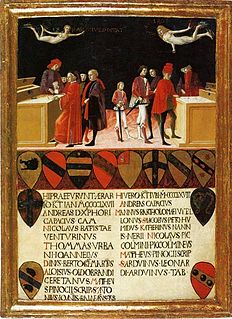
The Biccherna was the magistrate or chancellery of Finance from the 13th to the 14th century for the republic and then city of Siena, region of Tuscany, Italy.
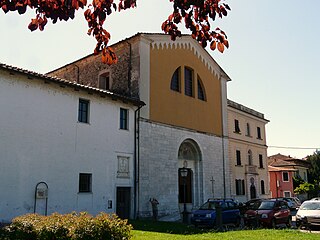
San Francesco is a Roman Catholic church and monastery located in Sarzana, region of Liguria, Italy.
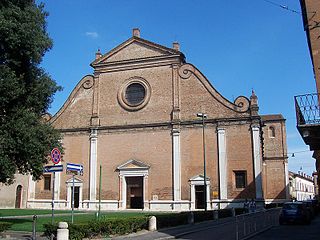
San Francesco is a late-Renaissance, Roman Catholic minor basilica church located on via Terranuova in Ferrara, region of Emilia-Romagna, Italy.

The Certosa di Pontignano, also known as the Certosa di San Pietro, is a Carthusian monastery and church in the neighborhood of Pontignano, within the town limits of Castelnuovo Berardenga, a few kilometers north of the city of Siena, in the region of Tuscany, Italy. The monastic complex, after the expulsion of the monks in 1810, passed through various hands, until it was acquired in 1959 by the University of Siena, and used for academic meetings, conventions, and also hotel and restaurant for events such as weddings and celebrations.

The Cappella di San Luca, also called dei Pittori is a chapel found in the cloisters of the convent of Santissima Annunziata in Florence, Italy. It was built to serve as the burial chapel for members of the Accademia del Disegno, and was donated by the Servites to the Academy in a document from 1565. It contains a collection of terracota statues from a number of prominent Florentine Mannerist sculptors.